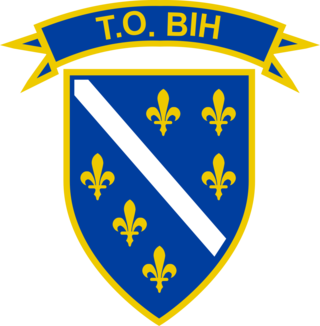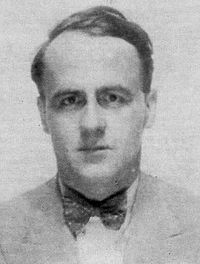
The Yugoslav People's Army, also called the Yugoslav National Army, was the military of the Socialist Federal Republic of Yugoslavia and its antecedents from 1945 to 1992.

Bihać is a city and the administrative centre of Una-Sana Canton of the Federation of Bosnia and Herzegovina, an entity of Bosnia and Herzegovina. It is situated on the banks of river Una in northwestern Bosnia and Herzegovina, in the Bosanska Krajina region. In 2013 its population was 56,261.

Tomislav Dretar is a Croatian, Bosnian, French and Belgian poet, writer, critic, and translator, as well as an academic, journalist, editor, political leader and president of Bihać's Croatian Defence Council during the Bosnian War. He is also known by the French alias Thomas Dretart.

The 1st Mechanized Guard Brigade - named "The Tigers" - was the most elite and best equipped military brigade of the Croatian Army. Its military base and headquarters was in the Croatian capital of Zagreb, origin of most of the brigade's personnel. In 2008, as part of a larger military restructuring, the brigade-sized unit was disbanded and reformed as a battalion of the Motorized Guard Brigade.
Operation Sana was the final military offensive of the Army of the Republic of Bosnia and Herzegovina in western Bosnia and Herzegovina and the last major battle of the Bosnian War. It was launched from the area of Bihać on 13 September 1995, against the Army of Republika Srpska, and involved advances towards Bosanski Petrovac, Sanski Most and Bosanska Krupa. At the same time, the Croatian Army and the Croatian Defence Council were engaging the VRS in Operation Maestral 2 further to the southeast. After an initial 70-kilometre (43 mi) advance, VRS reinforcements managed to stop the ARBiH short of Sanski Most and Novi Grad, and reversed some of the ARBiH's territorial gains in a counterattack. After a part of the ARBiH 5th Corps was threatened with defeat around the town of Ključ, the ARBiH requested assistance from the HV.

Operation Summer '95 was a joint military offensive of the Croatian Army (HV) and the Croatian Defence Council (HVO) that took place north-west of the Livanjsko Polje, and around Bosansko Grahovo and Glamoč in western Bosnia and Herzegovina. The operation was carried out between 25 and 29 July 1995, during the Croatian War of Independence and the Bosnian War. The attacking force of 8,500 troops commanded by HV's Lieutenant General Ante Gotovina initially encountered strong resistance from the 5,500-strong Army of Republika Srpska (VRS) 2nd Krajina Corps. The HV/HVO pushed the VRS back, capturing about 1,600 square kilometres of territory and consequently intercepting the Knin—Drvar road—a critical supply route of the self-declared Republic of Serbian Krajina (RSK). The operation failed to achieve its declared primary goal of drawing VRS units away from the besieged city of Bihać, but it placed the HV in position to capture the RSK's capital Knin in Operation Storm days later.

The 5th Corps was one of seven corps of the Army of the Republic of Bosnia and Herzegovina. The formation was around the Bihać pocket to protect it against the surrounding Serb forces. The Fifth Corps also fought secessional Bosniak forces loyal to Fikret Abdić, who was cooperating with Serb forces. In the last military action of the ARBiH, Operation Sana, the corps defeated Abdić's supporters and brought a number of regions of Bosnia and Herzegovina under government control. In April 2018, police detained Atif Dudaković and 12 others on suspicion of committing crimes against humanity during the Bosnian war. The court process is still ongoing.

This section is about the history of the Army of the Republic of Bosnia and Herzegovina that existed from 1992 to 1995, then it was formed into two armies of the two entities from 1998 to 2005 and finally transformed into the Armed Forces of Bosnia and Herzegovina (OSBIH).

During the Bosnian War, there was an ethnic cleansing campaign committed by the Bosnian Serb political and military leadership – Army of the Republika Srpska, mostly against Bosniak and Croat civilians in the Prijedor region of Bosnia and Herzegovina in 1992 and 1993. The composition of non-Serbs was drastically reduced: out of a population of 50,000 Bosniaks and 6,000 Croats, only some 6,000 Bosniaks and 3,000 Croats remained in the municipality by the end of the war. After the Srebrenica massacre, Prijedor is the area with the second highest rate of civilian killings committed during the Bosnian War. According to the Sarajevo-based Research and Documentation Center (IDC), 4,868 people were killed or went missing in the Prijedor municipality during the war. Among them were 3,515 Bosniak civilians, 186 Croat civilians and 78 Serb civilians. As of October 2013, 96 mass graves have been located and around 2,100 victims have been identified, largely by DNA analysis.

The Territorial Defence Force of the Republic of Bosnia and Hercegovina were the first official armed forces of the Republic of Bosnia and Herzegovina at the beginning of the Bosnian War. They were eventually transformed into the Army of the Republic of Bosnia and Herzegovina.

Mladen Stojanović was a Bosnian Serb and Yugoslav physician who led a detachment of Partisans on and around Mount Kozara in northwestern Bosnia during World War II in Yugoslavia. He was posthumously bestowed the Order of the People's Hero.
Operation Winter '94 was a joint military offensive of the Croatian Army (HV) and the Croatian Defence Council (HVO) fought in southwestern Bosnia and Herzegovina between 29 November and 24 December 1994. The operation formed part of the Croatian War of Independence and the Bosnian War fought between Bosnia and Herzegovina, Croatia and two unrecognized para-states proclaimed by Croatian Serbs and Bosnian Serbs. Both para-states were supported by the Yugoslav People's Army (JNA) and Serbia. The JNA pulled out in 1992, but transferred much of its equipment to the Bosnian Serb and Croatian Serb forces as it withdrew.
Operation Una was a military offensive conducted by the Croatian Army against the Army of Republika Srpska in western Bosnia and Herzegovina on 18–19 September 1995, during the Bosnian War. The operation entailed a crossing of the Una and Sava rivers to establish bridgeheads at Novi Grad, Bosanska Dubica, Bosanska Kostajnica and opposite Jasenovac to allow for a subsequent advance towards Prijedor and Banja Luka.
The 5th Corps of Air Force and Air Defense was a joint unit of Yugoslav Air Force established in 1964 as 5th Aviation Corps.

The Partisan Long March was the redeployment of Josip Broz Tito's Partisan Supreme Headquarters and the major fighting elements of the Yugoslav Partisans across the Independent State of Croatia, from south-eastern to north-western Bosnia that commenced in late June 1942. The march followed the first large-scale joint German-Italian counter-insurgency operation in the NDH, Operation Trio, and the combined Italian-Montenegrin Chetnik offensive in Montenegro and eastern Herzegovina.

The Bihać operation was a military operation conducted by Yugoslav partisans against the Independent State of Croatia (NDH) and Nazi Germany during World War II. The aim of the operation was to capture Bihać and the surrounding towns to connect Partisan held areas in Bosanska Krajina, and Knisnka Krajina. The battle for the city of Bihać lasted from 2 November to 4 November 1942. After capturing the city, the partisans continued to fight in surrounding areas until 15 November. The operation resulted in a major Partisan victory, with Bihać and the surrounding areas being captured, and the NDH suffering significant casualties.

Petar Matić Dule is Yugoslav Partisan World War II veteran, former lieutenant general of the Yugoslav People's Army (JNA), politician, socio-political worker, and the last living People's Hero of Yugoslavia.
The 501st Celebrated Mountain Brigade was formed on July 19, 1992, as the First Bihać Infantry Brigade in Kamenica near Bihać, with the aim of defending Bihać and its surroundings from Serbian attacks. Although the brigade had no problems with the number of men, the main problem of this brigade and the entire Army of the Republic of Bosnia and Herzegovina was the lack of weapons and military equipment, despite its contribution during the War in Bosnia and Herzegovina was extremely significant and large.

Operation "Breza 94" was the official codename for the military offensive conducted by the 1st Krajina Corps of the VRS in September 1994 in Bosanska Krajina. The objective of the offensive was the breaking of the 5th Corps and the conquest of Bosanska Krajina. The offensive ended in VRS defeat with the ARBiH capturing 20 square kilometers previously held by Serbs.
Operation Bosanska Krajina was the code name of the Army of Republika Srpska (VRS) offensive during the Bosnian War which aimed to capture the municipalities of Prijedor, Sanski Most and Ključ. The offensive was also the response of the VRS to the Army of the Republic of Bosnia and Herzegovina (ARBiH) attack on the city of Prijedor. The operation ended with the victory of the VRS and the beginning of the siege of Bihać.














